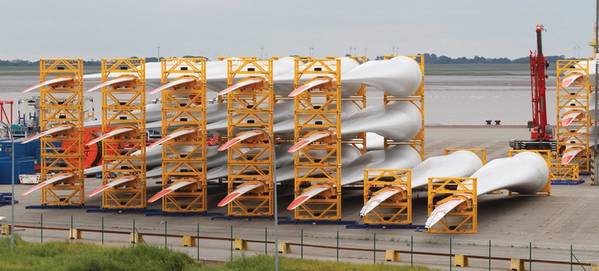
At the end of 2019 – December 27, to be exact – the US Department of Transportation, Office of the Secretary – filed a request for information regarding the development of a National Freight Strategic Plan (NFSP), required by the multi-year federal transportation bill, passed in 2015, called the FAST Act – “Fixing America’s Surface Transportation.”
By the close of the public comment period (Feb. 10) DOT had received 82 comments. Importantly, for the maritime industry, maritime businesses and trade groups, as well as many State DOTs, stepped up and emphasized how critical it is for a national freight plan to be multimodal, that such a plan needs to build on the strengths of each transport mode, so that, hopefully, a final plan is greater than the sum of its parts.
Interestingly, though, DOT didn’t receive any comments focused on the new and difficult freight issues presented by offshore wind (OSW).
Critically, OSW ports will require specific and deliberate attention across all modes – rail, truck, marine. This will be the big stuff, too, not just a designated turn lane. These investments will be expensive. It’s not too far-fetched to think that in some states transportation infrastructure for offshore wind might need its own dedicated funding. Timing is critical, too. New York’s OSW schedule, for example, is aggressive. Port projects need funding sooner, really, right now, not later.
New York has high-level estimates for some OSW port upgrades. A January 2019 study estimates it will take $314.4 million to upgrade the Port of Albany-Rensselaer. That excludes, however, some important work, from utilities (not defined) to “public access” (roads, highways…?), to environmental mitigation. The estimate for another port, the South Brooklyn Marine Terminal: $297 million, again excluding critical project line items.
NY’s state energy agency plans to make $200 million available for help with port requirements. That’s a lot of money but keep in mind New York officials want the social and economic benefits from OSW investments to impact large sections of the state, at least from Staten Island to Albany. Demands from numerous ports could use up that $200 million pretty quickly.
In its comments to USDOT, New York State officials do not mention OSW development and ports. Likewise, there’s no reference to wind energy port requirements from the Capital District Transportation Committee (Albany), a region supposedly under consideration for wind-port development.
Ditto for New Jersey officials, who are similarly planning imminent investments in OSW port facilities.
For a freight system and freight activities, OSW demands singular attention. OSW ports require large tracts of land. Manufacturing, assembly and storage logistics will require access, maybe new or upgraded access considering the size and weight of turbines and support structures. Road and highway projects are usually paid for via federal and state gas taxes. Additionally, local projects require local approvals and sometimes a local funding match. Some maritime projects are subsidized by MARAD and DOT grants, but most port upgrades are paid for either by a port’s private sector tenants or financed through the rent from those tenants. For an OSW port, all bills due may be paid largely by taxpayers and ratepayers; all costs and project financing need to be very clear, upfront. Rail, of course, largely depends on private railroads.
This is not easy work. And there are details that most American cities aren’t familiar with. Consider, for example, the extent of freight planning that occurs in some European cities.
“Even local governments have played a significant role. For example, in manufacturing and port areas, streets are designed to facilitate the passage of turbine blades and other large parts with street poles that fold flat and with traffic circles that have wide, straight shortcuts through the middle.”
That’s a description of wind-freight logistics and infrastructure in Denmark, captured in a report by Robert Collier for the University of California at Berkeley Labor Center. Is there a MARAD discretionary grant program to pay for folding utility poles at urban intersections?
These exact moves may not be required in towns in Staten Island or Humboldt Bay, Calif. or Cleveland, Ohio. But if people are thinking about a National Freight Strategic Plan, freight has to move – efficiently, safely, dependably. Otherwise, why plan? Again, the demands for offshore wind are new and they will present within America’s most populated and congested regions – from Virginia to Maine and along the Pacific coast.
It would seem, then, that in states where offshore wind is an urgent priority, there might be an effort to anticipate and coordinate the planning, financing and construction that new OSW ports will require. It would be unfortunate if a National Freight Strategic Plan were finalized without referencing the complex demands presented by building this new energy source.